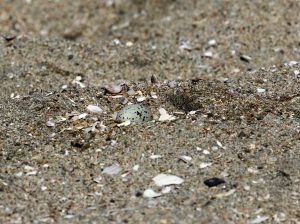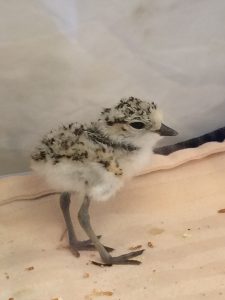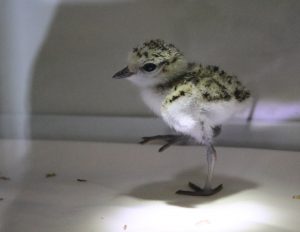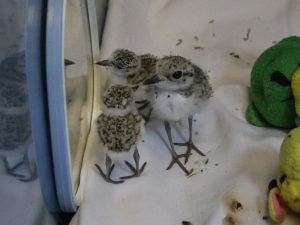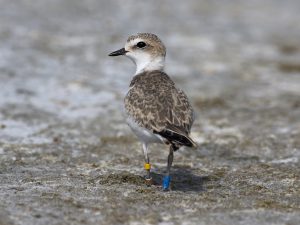The amazing story of Eureka, the Western Snowy Plover, began with an unexpected event on Memorial Day weekend of 2017. I do quarterly surveys for Western Snowy Plover (Charadrius nivosus nivosus), an endangered species along the west coast of North America. We survey a 2.2-mile stretch of Huntington State Beach in Orange County, CA. With my teammates, Doug and Chuck, we’ve surveyed this beach every January, March, May and September for four years. Huntington State Beach is a crucial roosting and feeding area for Western Snowy Plover, and we see some on every January, March or September survey.
Surveying takes three of us because the beach is quite deep at about 500 feet from the parking lot to the water’s edge. Our team walks in parallel, zig-zagging down the beach to cover everything. Snowy Plovers, with their pale, wet-sand plumage, can be hard to spot. They make it harder by crouching down in little divots on the beach, hiding until danger is right on top of them. May is the boring survey because it’s the only time we don?t see the plovers on our beach. By May, the plovers have migrated to their breeding areas elsewhere.
A Snowy Plover Discovery
So it was a huge surprise when Chuck called from the middle beach segment to say he had a plover. We converged on the spot, and there, just 100 feet from two sun-bathers, was a beautiful female Snowy Plover. We noted the location, and resumed surveying. A quarter mile down the beach, we found another Snowy Plover, this one an obvious male. The rest of the survey went by in a blur, and we rushed back to the female plover’s location. She was still there, and the beach around her was just a little bit disturbed… We backed off and waited. Pretty soon, she left to forage down at the water’s edge. When we examined the divot, there was this beautiful olive green egg with black speckles. We had just found the first active Western Snowy Plover nest on Huntington State Beach since 1993!
At that point, we began calling everyone! We flagged down a California State Parks mobile patrol with rangers Chris and Carl in it and told them of our discovery. They immediately called their boss, Lana Nguyen, and told her. Lana said she’d be with us in 45 minutes. State law requires California State Parks to manage for any endangered or threatened species on their property. They provided the resources we needed swiftly and efficiently. Chris and Carl drove off and came back with 10 large traffic cones, five stakes, and five signs. We contacted Tom Ryan of the US Fish and Wildlife Service (USFWS) for advice on how to deploy those resources, and he provided great information.
Protecting the Nest
We set up a cone perimeter about 50 feet in diameter around the nest. Then we posted a stake and sign in every other cone, without disturbing the incubating female plover. Meanwhile, the male plover showed up and watched from a nearby knoll on the beach.Then Lana arrived. She had contacted Peter Knapp, who watches over the terns and Snowy Plovers at Bolsa Chica Ecological Reserve (BCER) in nearby Huntington Beach. Peter gave Lana an exclosure cage, a device designed to protect plover nests. It’s a large wire cube, with a mesh big enough to allow plovers to come and go freely, but too narrow for predators like gulls to get at the nest.
We placed the cage over the nest, which did disturb the female – she ran off to join her mate on the knoll. We backed off a ways and sat down to watch. It was like they were teasing us. They approached the cage cautiously, running around it, then running through it, then standing just outside it, then walking into it together. Eventually, the female walked calmly up to the scrape and began incubating again. We quietly celebrated. Lana promised that State Parks would be back the next day to install wooden slat beach fencing at the 50-foot perimeter around the nest. We left, wondering what chance this nest had on such a busy and popular beach.
The First Twist
The story then took an unfortunate turn. State Parks informed us that less than 48 hours after discovering it, the parent plovers had abandoned the nest, for reasons unknown. There is no reason to believe that our actions caused the abandonment. We used the same techniques and equipment that scientists have used to safeguard the nests of endangered Piping and Snowy Plovers nationwide. Sometimes they just do this. Fortunately, when that happens, it doesn’t mean “game over” for the eggs. State Parks contacted the USFWS and Peter Knapp, who has a permit to do these things, came by and collected the egg, taking it to the Wetlands and Wildlife Care Center (WWCC) in Huntington Beach, practically across the street from the original nest site.
The WWCC placed the egg in a special incubator that mimics the temperature and humidity of an incubated plover nest. There the egg turns on very slow-moving roller bars, just like a parent plover would turn its eggs. Our egg was the 12th fertile egg that WWCC received that spring for the captive-rearing process. (They later received four more eggs that spring.) The WWCC has captive-reared Western Snowy Plover eggs since 1988.
As there was only one egg in the nest and Snowy Plovers typically lay two to three eggs per clutch, we knew something was odd about this nest. Typically, Snowy Plovers don?t begin incubating regularly until they’ve laid a full clutch. This is because they need to have synchronous hatching so they don’t end up tending some chicks while other eggs still need incubating. In all probability, gulls or raccoons already predated this nest before we found it. Anyway, WWCC experts guessed that our egg would hatch around 25-JUN-17.
A Second Twist Twist
On June 15th, Cheryl, one of the dedicated volunteers at WWCC, sent me an email and a cell phone photo. She arrived work that morning and found the chick from our egg, standing between the rollers! There’s no such thing as a “premies” with bird eggs. The Snowy Plover incubation period does not vary. Once incubation has begun, it always takes the same amount of time for an egg to hatch. That time varies from species to species, but experts know the incubation time for Snowy Plover eggs, so something else was going on. Evidently, these plovers were incubating eggs in this nest for about ten days before we found it. This suggests that his parents had laid additional eggs, and that something predated those eggs.
This is the grim reality of beach-nesting species like Piping and Snowy Plovers. It may also explain why the parents abandoned when we came by and put up all those cones and signs and fencing… Perhaps it was just the last straw. Since it was awkward to refer to this bird as “the bird from our egg”, I named it Eureka. So now, Eureka had hatched and was a healthy Snowy Plover chick, running around his temporary home and eating well. I say “he”, but of course, we don’t actually know Eureka’s sex. Snowy Plovers don’t obtain definitive gender-specific plumage until they are nearly a year old. Snowy Plover chicks are precocial. These chicks can run (surprisingly fast in fact!) within about 12 hours of hatching.
Captive-Rearing Snowy Plovers
When first hatched, Snowy Plovers look like fluffy, dark-speckled little beige cotton balls on black sticks. Eureka had all the comforts of a loving foster home: clean water, food, a mirror to create the illusion that he wasn’t alone, and a teddy bear to snuggle up to when resting. He was fed a diet of blood worms (larvae of marine polychaete worms) and meal worms. As he grew older, they augmented his diet with small crickets, to give him practice capturing live prey.
Once a Snowy Plover hatches, it takes about 35 days to replace its natal down with a full set of feathers. With those feathers comes the crucial ability to fly. Between the ages of three and fifteen days, Eureka lost his spots and fluffy appearance, acquiring the beige coloring of an adult plover. He also began to do that “plover thing” where they run, and then they stop, and then they run and stop again? People at the WWCC noticed that he seemed to want to join the older captive-reared Snowy Plover chicks, even though he was too young and small for this to be a good idea. Snowy Plover chicks are social like other birds, and enjoy the company of other plovers.
Eureka’s Release
Eureka was a bit slower than some plovers to achieve fully flight-capable plumage, so instead of releasing him right at 35 days, they kept him a little longer. They also moved him to an outside cage that allowed him short flights so he could build up some flight muscle. Finally, 39 days post-hatch, Eureka was ready for release. Cheryl, Lana, Peter and Ross (another tern and plover monitor and expert) gathered to release Eureka. They chose an area of BCER not open to the public. With no known Snowy Plover territories in the immediate vicinity, other Snowy Plovers would not chase Eureka around!
Cheryl brought the cage out, set it down on a mudflat, and opened the door. Seconds later, Eureka walked out and stopped. He ran a few steps, stopped again, and then did that plover bobbing thing, as though taking small bows. It was as though he couldn’t believe his good luck. “Really? They let me free?! I can go!” And then he did. He flew about ten yards and landed near some vegetation. He took a stab at something, probably a brine fly. Another pause, and then he launched. He flew beautifully and strongly, rapidly gaining altitude, swinging in a wide arc out beyond us, and then coming back over us, calling as he went. And then he was gone, a small bird on the wind in a large place.
About Captive Rearing
In the end, we have just questions, probabilities, and a few numbers. Captive breeding produced 12 Snowy Plovers for release so far this year, including Eureka. Six more Snowy Plovers remain at the WWCC. Observers recorded three of those 12 released plovers in the wild, including one at Camp Pendleton, some 25 miles south, and two at the Least Tern Preserve on Huntington State Beach. Both those sites are important roosting areas for Western Snowy Plover. This fact alone indicates that captive rearing works. These birds have enough deep instincts that they know how to be proper Snowy Plovers even without parents to rear and teach them. These are 18 birds that would not otherwise have survived to fly free or breed with others of their kind.
Estimates place the total coastal Western Snowy Plover population at about 2400-2800 individuals. That means this year’s crop of birds just from the WWCC represents about 0.6 to 0.7% of the population. This may not sound like much, but it’s huge. When a species gets too low in terms of total individuals, that species faces the hurdle of inbreeding depression. Simply put, the species lacks sufficient genetic diversity to have the ability to adapt to changing conditions. When that happens, deleterious genes or traits can pull the species down towards extinction.
Countering that grim thought, here are some positives. There are other captive rearing centers for Western Snowy Plovers, and they are releasing more birds each year. The captive-rearing process with Snowy Plovers continuously improves. More experience with these beautiful birds means more success at fostering them. Again: captive rearing works and has an important role in recovery of the Western Snowy Plover.
Final Questions and Epilogue
We still don’t know Eureka’s gender. If we are lucky enough to see Eureka again, by next spring he/she should be showing gender-definitive plumage. Will we see Eureka again? As noted above Western Snowy Plovers don’t show nest site fidelity. Just because a bird is born on a particular beach does not mean it will nest there subsequently. In Eureka’s case, he was still an egg when he left his natal beach, so he may not even know which beach is his. Or he may.
On the other hand, observers re-sighted 25% of the captive-reared birds released so far this year, so we can hope. Eureka’s left leg features yellow over tan bands, which marks him as a Bolsa Chica bird – the tan partially covers the silver USFWS band. His right leg has blue over blue bands. I can tell you, we will be looking for Eureka in future surveys. I can hardly wait for the September survey!


